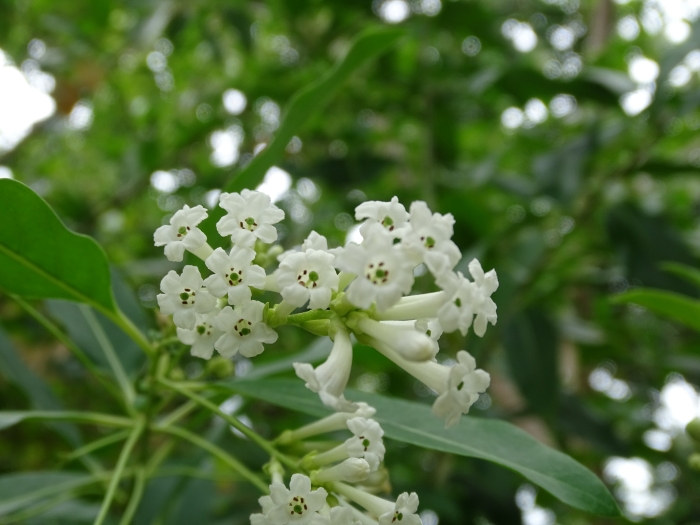Day-Blooming Jessamine
(Cestrum diurnum)
Day-Blooming Jessamine (Cestrum diurnum)
/
/

© Alexis López Hernández
CC BY 4.0
Image By:
© Alexis López Hernández
Recorded By:
Copyright:
CC BY 4.0
Copyright Notice:
Photo by: © Alexis López Hernández | License Type: CC BY 4.0 | License URL: http://creativecommons.org/licenses/by/4.0/ | Uploader: alexiz | Publisher: iNaturalist |

























Estimated Native Range
Summary
Cestrum diurnum, commonly known as day-blooming jessamine or day-blooming jasmine, is a semi-evergreen shrub native to Mexico and the Caribbean, thriving in tropical and subtropical habitats such as forest edges and open woodlands. It can grow up to 16 feet tall and is characterized by green branches that mature to a fawn color and dark green, ovate-lanceolate leaves. The plant is notable for its clusters of tubular white flowers that are sweet-smelling and release their fragrance during the daytime, attracting pollinators such as bees and butterflies. Following the flowering season, it produces black, nearly globular berries.
Day-blooming jessamine is valued for its fragrant flowers and is often used in ornamental plantings, hedges, and as a specimen plant in gardens. It prefers full sun to partial shade and requires well-drained soil with moderate moisture. While it can tolerate a range of soil types, it thrives in loamy or sandy soils. Gardeners should be aware that all parts of the plant are toxic if ingested, and it should be handled with care to avoid skin irritation. Due to its potential invasiveness, it is important to consult local regulations before planting Cestrum diurnum outside its native range.CC BY-SA 4.0
Day-blooming jessamine is valued for its fragrant flowers and is often used in ornamental plantings, hedges, and as a specimen plant in gardens. It prefers full sun to partial shade and requires well-drained soil with moderate moisture. While it can tolerate a range of soil types, it thrives in loamy or sandy soils. Gardeners should be aware that all parts of the plant are toxic if ingested, and it should be handled with care to avoid skin irritation. Due to its potential invasiveness, it is important to consult local regulations before planting Cestrum diurnum outside its native range.CC BY-SA 4.0
Plant Description
- Plant Type: Shrub
- Height: 6-8 feet
- Width: 4-6 feet
- Growth Rate: Moderate
- Flower Color: White
- Flowering Season: Spring, Summer, Fall
- Leaf Retention: Evergreen
Growth Requirements
- Sun: Full Sun, Part Shade
- Water: Medium
- Drainage: Medium
Common Uses
Butterfly Garden, Fragrant
Natural Habitat
native to Mexico and the Caribbean, thriving in tropical and subtropical habitats such as forest edges and open woodlands
Other Names
Common Names: Day Cestrum, Day Blooming Jasmine
Scientific Names: , Cestrum diurnum, Cestrum album, Cestrum album, Cestrum diurnum, Cestrum diurnum var. diurnum, Cestrum diurnum var. fasciatiflorum, Cestrum diurnum var. fastigiatum, Cestrum diurnum var. fastigiatum, Cestrum diurnum var. marcianum
GBIF Accepted Name: